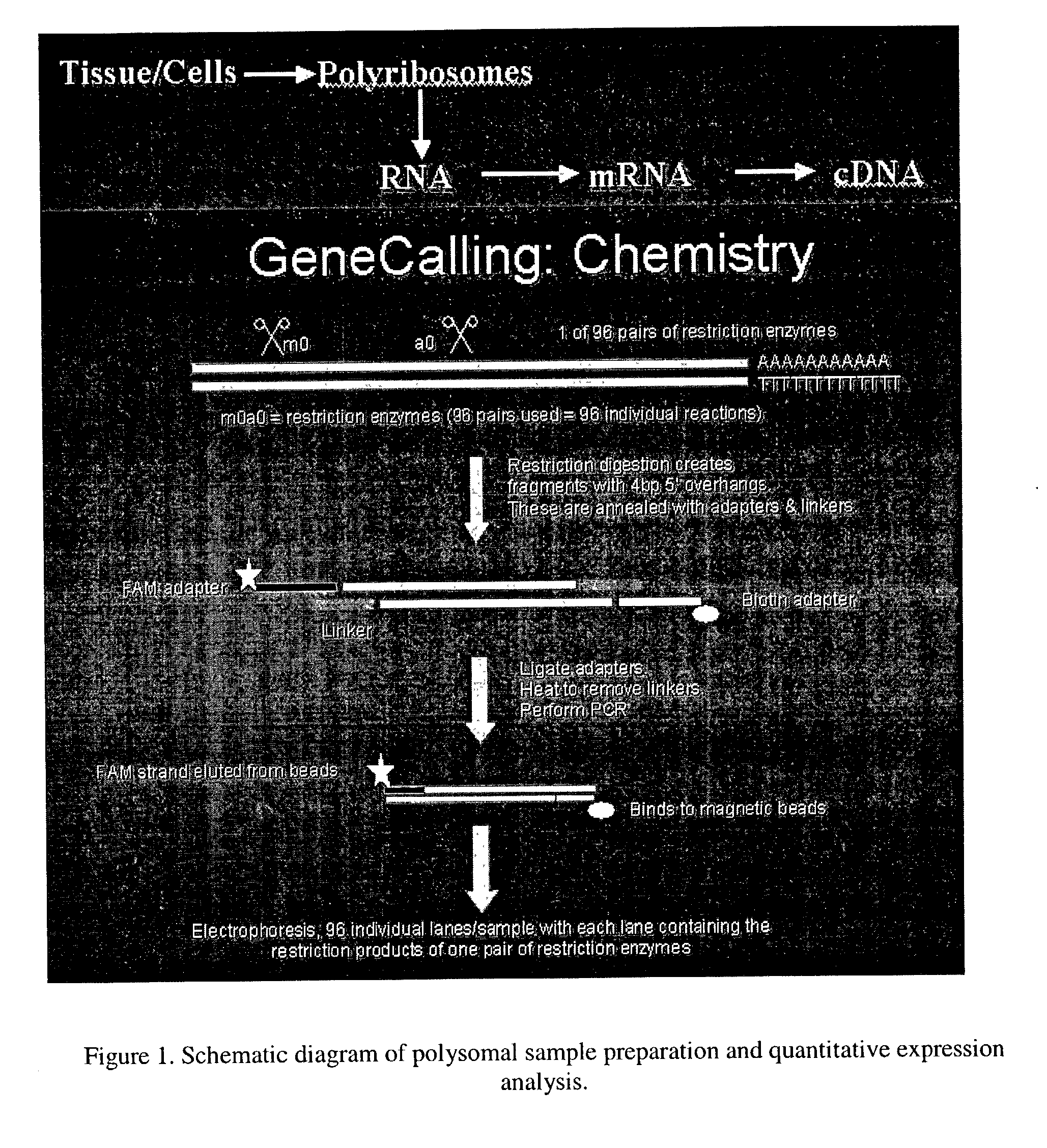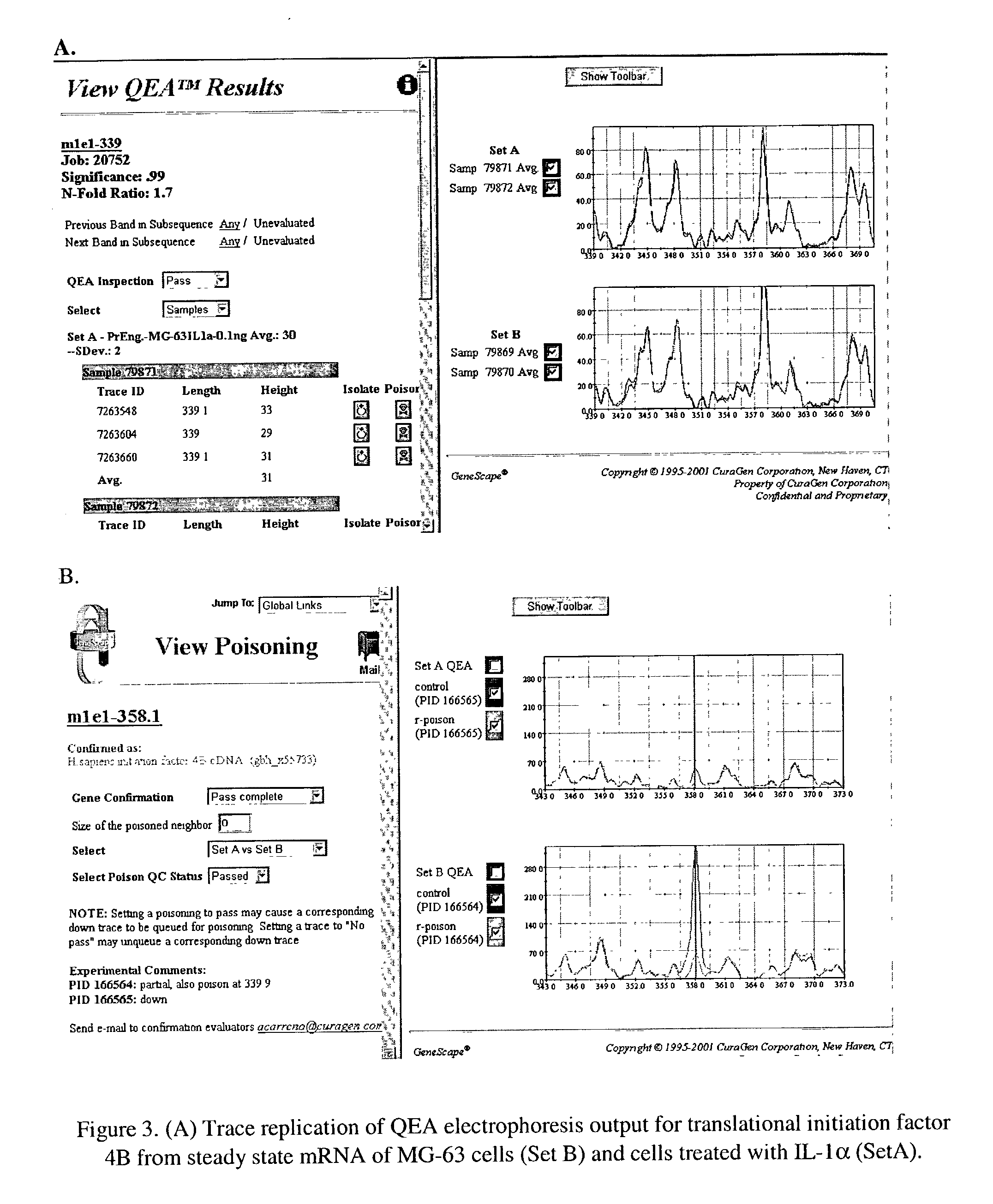Method for analyzing a nucleic acid
a nucleic acid and sequence technology, applied in the field of nucleic acid sequence classification, identification, or quantification, can solve the problem of not providing a measure of gene expression regulation occurring at the translational (or protein production) stag
- Summary
- Abstract
- Description
- Claims
- Application Information
AI Technical Summary
Benefits of technology
Problems solved by technology
Method used
Image
Examples
example 1
General Materials and Methods
Cell Culture
[0143] Human osteosarcoma MG-63 cells were maintained in MEM containing 10% fetal bovine serum at 37° C. and 5% CO2 with humidity. 3×106 cells / T175 flask MG63 cells were serum starved in MEM media containing 0.1% FBS for 24 hours and then treated with 10 ng / ml IL-1α for 6 hours. Rabbit anti-CAML polyclonal antibody was a kind gift from Dr. Richard J. Brani (Department of Pediatrics, Immunology, Mayo Clinic, Rochester, Minn.). Mouse anti-β-actin monoclonal antibody was purchased from Santa Cruz Biotech (Santa Cruz, Calif.). Cycloheximide was purchased from ICN.
Polyribosome Analysis
[0144] For preparation of cytoplasmic extracts, cells from three 175 cm2 tissue culture plates (30%) confluent were treated with cycloheximide (100 μg / ml; ICN) for 5 min. at 37° C., washed with ice cold PBS containing cycloheximide (100 μg / ml), and harvested by trypsinization (Johannes et al., PNAS 96:13118-13123, 1999). Cells and homogenates were also snap fro...
example 2
. Identification of Gene Transcripts Present in Different Levels in Polysomal mRNA from IL-1α0 Treated MG-63 Cells
[0148] Gene expression from polysomal isolated mRNAs in serum starved MG-63 cells and MG-63 cells induced with inflammation cytokine IL-1α was analyzed, as is shown in FIG. 1. Polysomal mRNA was isolated from total cell mRNA by sucrose density sedimentation centrifugation on 0.5M-1.5M sucrose gradients. FIG. 2 shows the optical density (OD) profile of sucrose gradients loaded with cell extracts from untreated and IL-1α treated MG-63 cells. In each gradient the top fractions with high OD values represent ribosomal RNAs associated with the 40S, 60S , 80S subunits, along with free mRNAs. Sample fractions with lower ODs contain the polysomal fractions with actively translated mRNAs. For expression analysis, fractions 8 to 13 containing polysomes were pooled, the mRNA isolated and converted to cDNA for expression analysis. In addition, polysomes were isolated from snap froze...
example 3
Microsomal Enrichment of Actively Translated mRNAs Encoding for Secreted or Membrane-associated Proteins
Materials
[0161] Materials used are Listed in Table 8.
TABLE 8Materials used in microsome mRNA enrichmentReagents / MaterialVendorStock NumberTK150 M *SucroseSigmaS-03890.8 M sucrose *1.3 M sucrose *2.05 M sucrose * 2.5 M sucrose *HeprinGibco BRL15077-019SuperaselnAmbion26962-mercaptoethanolSigmaM7154Falcon tube (15 ml)RNase ZapAmbion9780HomogenizerGlas-Coltube and pestle setGlas-Col099C S440DEPC-waterAmbion9922Beckman centrifuge tubes (17 ml)Beckman344061
Methods
Preparing Pestles and Tubes: [0162] Use RNase Zap to zap cleaned Teflon pestle and tube sets, followed by rinsing with DEPC treated water. [0163] Set Teflon pestles and tubes on ice.
Preparing Tissues: [0164] Fresh mouse tissue were carefully minced with scalpel and then soaked with soaking buffer containing 1001 μg / ml of cycloheximide for 10 minutes. Buffer then removed and tissue sample will then be snap freeze with...
PUM
| Property | Measurement | Unit |
|---|---|---|
| Fraction | aaaaa | aaaaa |
| Fraction | aaaaa | aaaaa |
| Volume | aaaaa | aaaaa |
Abstract
Description
Claims
Application Information
 Login to View More
Login to View More - R&D
- Intellectual Property
- Life Sciences
- Materials
- Tech Scout
- Unparalleled Data Quality
- Higher Quality Content
- 60% Fewer Hallucinations
Browse by: Latest US Patents, China's latest patents, Technical Efficacy Thesaurus, Application Domain, Technology Topic, Popular Technical Reports.
© 2025 PatSnap. All rights reserved.Legal|Privacy policy|Modern Slavery Act Transparency Statement|Sitemap|About US| Contact US: help@patsnap.com



